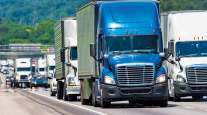Colorado Budget Cuts Will Hamper Freight Movement in State

Colorado’s Department of Transportation, which already has an $800 million annual funding shortfall, is taking another $80 million hit in fiscal 2018 and fiscal 2019 in Gov. John Hickenlooper’s proposed budget.
Tony Milo, executive director of the Colorado Contractors Association, was disappointed but not surprised by the coming cuts.
“There are budget categories that require spending and, unfortunately, transportation isn’t one of those constitutionally protected areas,” Milo said. “So when the governor was looking at the $500 million budget shortfall, transportation was one of the areas that took a hit.”
CDOT spokeswoman Amy Ford said the department had lost all general funding during the 2008-2009 recession but some was restored as the economy improved in recent years.
“That’s what the governor is proposing to cut now that the economy has shifted again,” said Ford, who noted that the vast majority of CDOT’s budget comes from fuel taxes with a portion derived from vehicle registration fees. “The proposed cuts grow that funding gap. We’re going to have to delay some projects. The situation is getting dire in Colorado.”
Given Colorado’s 50% population growth over the past two decades and the expected repeat during the next 20 years, the headaches for freight movement in the state figure to worsen. Fort Collins, between Denver and the Wyoming line, has been one of the nation’s fastest-growing areas in recent years and is projected to double its population over the next two decades.
“An incredible amount of freight is transported on I-25,” Ford said. “The stretch between Castle Rock and Monument, where we won’t have identified funds to work on [adding a lane] for a while is a critical stretch that connects Colorado Springs to Denver. "We have been expanding capacity, and this is the last gap where it’s only two lanes in each direction. From a freight perspective, there’s no such thing as avoiding the heavy traffic because it’s almost all day long.”
Colorado Motor Carriers Association President Greg Fulton said his members deal with that congestion daily and not just on Interstate 25 but also on I-70, the state’s main east-west highway, and other freight corridors.
“From Colorado Springs up to Fort Collins, that corridor doesn’t really see traffic fall off after peak periods,” Fulton said. “You can’t navigate around even the most minor incident. The peak periods are expanding and we don’t have a lot of alternative routes.
"To avoid I-25, you can take I-225 around Denver, but that’s usually jammed. With I-70, the alternative is in Wyoming. USDOT says that in the Denver area it costs about $25,000 extra per truck annually due to congestion. The cuts are going to exacerbate an already bad situation.”
CMCA supports increases in fuel taxes and/or sales taxes or the issuance of bonds to close the funding gap. Milo’s organization is hoping to persuade a majority in the Legislature to put a transportation funding measure on next year’s ballot. Fuel taxes haven’t risen since 1991 in Colorado where they have to be approved by the voters.
“The budget cuts drove the point home that now more than ever we need to get serious in finding a new, stable funding source for transportation,” Milo said. “Traditionally, it’s been user fees and [fuel] taxes. Even if we were able to increase them, with more fuel-efficient cars, hybrids and electric vehicles, it’s becoming less and less of a viable source of funding."
Milo said that a half-cent sales tax increase can raise between $500 million and $600 million a year for transportation projects and that it has gained the support of a majority of voters in three statewide polls over the past 18 months.
“We think we’re at a tipping point now where even voters in more conservative areas are finding that the traffic has become unmanageable, and they’re willing to pay a little bit more to help fix it assuming that the money is dedicated to a project list,” Milo said.
In the meantime, as Ford said, CDOT “keeps trying to do more with less. We’re getting to a point where we’re starting to do less with less, which means people sitting in congestion and waiting for improvements that don’t happen.”




